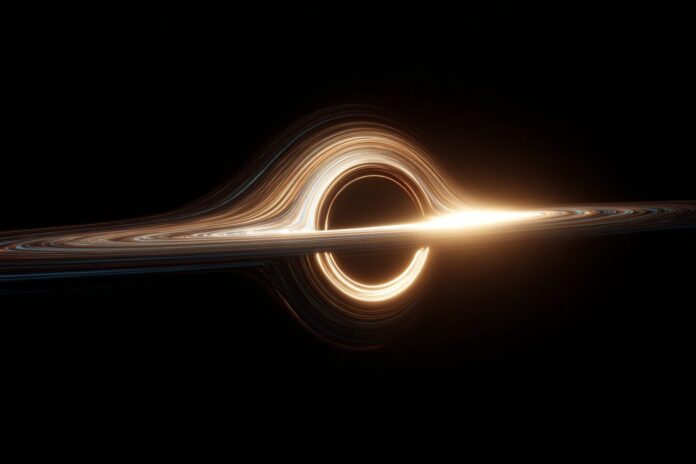For the First Time: Simulating the Shadows at a Black Hole’s Edge
In a striking advance for astrophysics, scientists have successfully simulated what is known as the “shadow realm” at the edge of a black hole. This breakthrough grants researchers an unprecedented look at how light, plasma, magnetic fields, and gravity interact in the most extreme conditions known in the universe.
Most importantly, this simulation bridges the gap between theoretical models and observational data. Because the interactions near the event horizon are too complex for simple approximations, advanced techniques such as general relativistic magnetohydrodynamic simulations (GRMHDS) have been employed to move beyond simplistic interpretations and capture the dynamic interplay of these forces. Therefore, the study not only deepens our understanding of black hole physics but also sets a new standard for simulating extreme cosmic phenomena.
Defining the Black Hole Shadow Realm
The “shadow realm” refers to the turbulent area that lies just beyond a black hole’s visible shadow—the region where gravity is so intense that even light cannot break free. Because this enigmatic zone is a hotbed of energy, it hosts high-energy particles that swirl in the gravitational grip, along with twisted magnetic fields and rapidly changing radiative phenomena.
Moreover, the environment is characterized by energetic jets and luminous arcs, which provide crucial insights into the structure and behavior of black holes. These dynamic features are critical for researchers, because understanding them paves the way toward explaining not only jet production but also the mechanics behind particle acceleration near these cosmic giants.
Breakthrough Simulations: Modeling the Unseen
Under the leadership of Chael’s research group, the new study employed sophisticated GRMHDS to realistically model the extreme conditions at play. With the aid of state-of-the-art computing platforms such as the Extreme Science and Engineering Discovery Environment (XSEDE) and the Advanced Cyberinfrastructure Coordination Ecosystem (ACCESS), the team could simulate intricate interactions involving plasma, electrons, protons, and intense gravitational forces. As explained in the ScienceAlert article, this approach allowed for unprecedented resolution of both macroscopic flows and the minute behavior of individual particles.
Because the simulation resolves dynamic processes in real-time, it helps illustrate how even subtle changes in particle behavior or magnetic field orientation can lead to significant variations in the observed structure of a black hole’s shadow. Besides that, these technological advances are essential for linking theoretical predictions with observational data captured by instruments like the Event Horizon Telescope.
Technological Breakthroughs and Their Implications
Recent innovations in supercomputing and algorithm design have been pivotal in advancing black hole simulations. Most importantly, these improvements have enhanced the capability to integrate phenomena such as star quakes and shock waves that can accompany black hole dynamics, as noted in recent studies on astrophysics (see Phys.org).
Because the upgraded simulation frameworks capture the complex interplay of forces with greater accuracy, researchers can now test and refine models that predict jet formation and energy emissions in regions close to the black hole. Therefore, these simulations not only inform our understanding of black holes but also enable more reliable cross-checks with observational data, significantly boosting confidence in astrophysical interpretations.
Peering into the Shadows: Observational Parallels and Enhanced Visualizations
The simulated images reveal hot electrons and swirling plasma that spiral immediately outside the black hole’s shadow. Because these elements interact strongly with magnetic fields, they create luminous arcs and dramatic dark regions that are reminiscent of the visual impressions captured by the Event Horizon Telescope, as highlighted by researchers at the University of Arizona (University of Arizona News).
Moreover, the simulation demonstrates that even minor variations in particle energy or magnetic orientation can lead to observable changes. This insight is critical for astronomers interpreting telescope images, because it enables a more nuanced understanding of how black holes project their gravitational influence into the surrounding cosmos. Because this methodology bridges simulation with observation, it lays the groundwork for future studies that may reveal even more about dark matter boundaries and the energetic environments surrounding black holes.
Looking Forward: The Future of Black Hole Research
Because our technological capabilities are evolving rapidly, the next phases of research may enable real-time modeling of black hole environments. As simulations become even more precise, scientists anticipate linking these models with active data streams from radio telescopes, thus providing continuous updates on the shifting dynamics of these cosmic enigmas.
Most importantly, this approach promises to enrich our understanding of not only black holes but also other extreme environments such as neutron star mergers and gamma-ray bursts. Therefore, as the field advances, the interplay between simulation and empirical observation will likely unveil further mysteries behind the universe’s most violent phenomena, paving new roads in astrophysical research.
Further Exploration and Research Opportunities
For those interested in diving deeper into the subject, a wealth of resources is available. The original research and supplementary simulation visuals can be further explored through several compelling platforms. For instance, the detailed breakdown on how simulations are constructed is available at Elliott Elford’s website, which provides interactive accounts and technical insights.
Additionally, you can explore historical perspectives on black hole imaging in the comprehensive review provided by Futura Sciences, tracing 45 years of pioneering work and the evolution of simulation techniques (Futura Sciences). Besides that, these resources collectively highlight the ongoing progress and future potential in understanding black hole mechanics and cosmic evolution.



